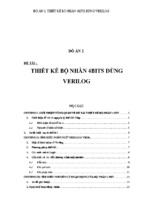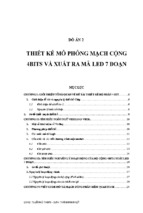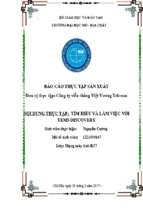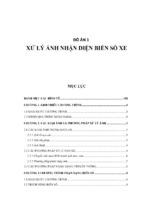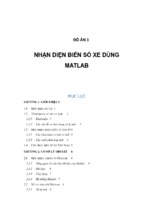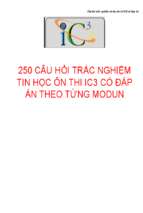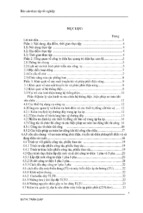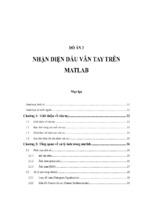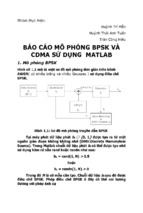Florida State University Libraries
Electronic Theses, Treatises and Dissertations
The Graduate School
2004
Adaptive Filter Architectures for FPGA
Implementation
Joseph Petrone
Follow this and additional works at the FSU Digital Library. For more information, please contact
[email protected]
THE FLORIDA STATE UNIVERSITY
COLLEGE OF ENGINEERING
ADAPTIVE FILTER ARCHITECTURES FOR FPGA IMPLEMENTATION
By
JOSEPH PETRONE
A Thesis submitted to the
Department of Electrical and Computer Engineering
in partial fulfillment of the
requirements for the degree of
Master of Science
Degree Awarded:
Summer Semester, 2004
The members of the Committee approve the thesis of Joseph Petrone defended
on 29th of June 2004.
_______________________________
Simon Y Foo
Professor Directing
_______________________________
Uwe Meyer‐Baese
Committee Member
_______________________________
Anke Meyer‐Baese
Committee Member
Approved:
______________________________________________
Reginald Perry, Chair, Department of Electrical and Computer Engineering
______________________________________________
Ching‐Jen Chen, Dean, FAMU‐FSU College of Engineering
The Office of Graduate Studies has verified and approved the above named
committee members.
ii
ACKNOWLEDGEMENTS
I would like to thank my major professor Dr. Simon Foo for his guidance
and support throughout my graduate study at FSU. I would like to thank the
members of my thesis committee, Dr. Uwe Meyer‐Baese and Dr. Anke Meyer‐
Baese, for their valuable advice and guidance. I wish to thank the academic and
administrative staff at the Department of Electrical and Computer Engineering
for their kind support. I would also like to thank my family and friends for their
continuous support and confidence in me.
iii
TABLE OF CONTENTS
List Of Acronyms ........................................................................................................ vi
List Of Figures .............................................................................................................viii
List Of Tables ............................................................................................................... ix
Abstract ......................................................................................................................... x
1 Introduction
1.1 Purpose.................................................................................................................. 1
1.2 Overview ............................................................................................................... 1
1.2.1 Advantages of DSP ..................................................................................... 2
1.2.2 Reconfigurable Hardware Advantages ................................................... 2
1.3 Organization of Thesis ........................................................................................ 3
2 Programmable Logic Devices
2.1 History of Programmable Logic ......................................................................... 4
2.2 FPGA Architecture................................................................................................ 6
2.3 Device Configuration ........................................................................................... 9
2.3.1 Schematic Design Entry .............................................................................. 9
2.3.2 Hardware Description Languages ............................................................11
2.3.3 High‐Level Languages ................................................................................11
2.4 Current Trends ......................................................................................................12
3 Adaptive Filter Overview
3.1 Introduction .......................................................................................................... 13
3.2 Adaptive Filtering Problem................................................................................ 14
3.3 Applications.......................................................................................................... 15
3.4 Adaptive Algorithms........................................................................................... 16
3.4.1 Wiener Filters............................................................................................... 17
3.4.2 Method of Steepest Descent ...................................................................... 19
3.4.3 Least Mean Square Algorithm .................................................................. 20
3.4.4 Recursive Least Squares Algorithm ......................................................... 21
4 FPGA Implementation
4.1 FPGA Realization Issues ..................................................................................... 23
4.2 Finite Precision Effects ........................................................................................ 24
iv
4.2.1 Scale Factor Adjustment............................................................................. 24
4.2.2 Training Algorithm Modification............................................................. 27
4.3 Loadable Coefficient Filter Taps ........................................................................ 31
4.3.1 Computed Partial Products Multiplication............................................. 31
4.3.2 Embedded Multipliers ............................................................................... 34
4.3.3 Tap Implementation Results ..................................................................... 34
4.4 Embedded Microprocessor Utilization............................................................. 37
4.4.1 IBM PowerPC 405 ....................................................................................... 37
4.4.2 Embedded Development Kit..................................................................... 38
4.4.3 Xilinx Processor Soft IP .............................................................................. 38
4.4.3.1 User IP Cores ................................................................................... 39
4.4.4 Adaptive Filter IP Core .............................................................................. 41
5 Results
5.1 Methods Used....................................................................................................... 42
5.2 Algorithm Analyses............................................................................................. 44
5.2.1 Full Precision Analysis ............................................................................... 44
5.2.2 Fixed‐Point Analysis................................................................................... 46
5.3 Hardware Verification......................................................................................... 48
5.4 Power Consumption............................................................................................ 49
5.5 Bandwidth Considerations ................................................................................. 50
6 Conclusions
6.1 Conclusions........................................................................................................... 52
6.2 Future Work.......................................................................................................... 53
Appendix A Matlab Code........................................................................................... 55
Appendix B VHDL Code............................................................................................ 59
Appendix C C Code .................................................................................................... 75
Appendix D Device Synthesis Results ................................................................... 80
References ..................................................................................................................... 83
Biographical Sketch .................................................................................................... 86
v
LIST OF ACRONYMS
ASIC
CLB
CPLD
DA
DKCM
DSP
EDK
FPGA
FPLD
FPU
HDL
I/O
IP
IPIC
IPIF
ISE
JTAG
KCM
LE
LMS
LUT
MAC
MIPS
MMI
MMU
OPB
PAL
PLA
PLB
PLD
PROM
RAM
RISC
RLS
Application Specific Integrated Circuit
Configurable Logic Block
Complex Programmable Logic Device
Distributed Arithmetic
Dynamic Constant Coefficient Multiplier
Digital Signal Processing
Embedded Development Kit
Field Programmable Gate Array
Field Programmable Logic Device
Floating‐Point Unit
Hardware Description Language
Input/Output
Intellectual Property
IP Interconnect
IP Interface
Integrated Software Environment
Joint Test Action Group
Constant Coefficient Multiplier
Logic Element
Least‐Mean‐Square
Look‐up Table
Media Access Control
Million Instructions per Second
Monolithic Memories Inc.
Memory Management Unit
On‐chip Peripheral Bus
Programmable Array Logic
Programmable Logic Array
Processor Local Bus
Programmable Logic Device
Programmable Read Only Memory
Random Access Memory
Reduced Instruction Set Computer
Recursive Least‐Squares
vi
ROM
RTL
SoC
SRAM
TLB
UART
VCM
VHDL
VHSIC
VLSI
Read Only Memory
Register Transfer Level
System‐on‐Chip
Static Random Access Memory
Translation Look‐aside Buffer
Universal Asynchronous Receiver‐Transmitter
Variable Coefficient Multiplier
VHSIC Hardware Description Language
Very High Speed Integrated Circuit
Very Large Scale Integration
vii
LIST OF FIGURES
2.1 PLA Structure ......................................................................................................... 5
2.2 SRAM based FPGA Configuration....................................................................... 6
2.3 Island Style FPGA Routing Architecture............................................................. 7
2.4 Virtex‐II Pro Slice .................................................................................................... 8
2.5 Half‐Adder Schematic ............................................................................................ 10
3.1 Signal with interference ......................................................................................... 13
3.2 Adaptive filter block‐diagram............................................................................... 14
3.3 Adaptive filter applications................................................................................... 16
3.4 Error‐performance surface..................................................................................... 18
4.1 Direct and transposed form FIR ........................................................................... 28
4.2 Multiplier CLB resources ....................................................................................... 35
4.3 Partial Products Multiplier .................................................................................... 36
4.4 PPC embedded design ........................................................................................... 39
4.5 IPIF block diagram.................................................................................................. 40
4.6 Hybrid Adaptive Filter Design ............................................................................. 41
5.2 Full‐precision results .............................................................................................. 45
5.3 LMS and RLS error ................................................................................................. 46
5.4 Fixed‐point results .................................................................................................. 47
5.5 Transposed‐form result.......................................................................................... 48
5.6 PCI data flow ........................................................................................................... 49
5.7 Power consumption................................................................................................ 50
viii
LIST OF TABLES
2.1 Half‐Adder Truth Table ......................................................................................... 9
4.1 Partial products Table ............................................................................................ 32
4.2 Multiplier reconfiguration times .......................................................................... 36
5.1 Filters implemented................................................................................................ 43
5.2 Number of Operations for RLS Algorithm................................................................ 51
ix
ABSTRACT
Filtering data in real-time requires dedicated hardware to meet
demanding time requirements. If the statistics of the signal are not known, then
adaptive filtering algorithms can be implemented to estimate the signals statistics
iteratively.
Modern field programmable gate arrays (FPGAs) include the
resources needed to design efficient filtering structures.
Furthermore, some
manufacturers now include complete microprocessors within the FPGA fabric.
This mix of hardware and embedded software on a single chip is ideal for fast
filter structures with arithmetic intensive adaptive algorithms.
This thesis aims to combine efficient filter structures with optimized code
to create a system-on-chip (SoC) solution for various adaptive filtering problems.
Several different adaptive algorithms have been coded in VHDL as well as in C
for the PowerPC 405 microprocessor. The designs are evaluated in terms of
design time, filter throughput, hardware resources, and power consumption.
x
CHAPTER 1
Introduction
On systems that perform real‐time processing of data, performance is
often limited by the processing capability of the system [1]. Therefore,
evaluation of different architectures to determine the most efficient architecture
is an important task. This chapter discusses the purpose of the thesis, and
presents an overview and the direction.
1.1 Purpose
The purpose of this thesis is to explore the use of embedded System‐on‐
Chip (SoC) solutions that modern Field Programmable Gate Arrays (FPGAs)
offer. Specifically, it will investigate their use in efficiently implementing
adaptive filtering applications. Different architectures for the filter will be
compared. In addition, the PowerPC embedded microprocessor will be
employed for the various training algorithms. This will be compared to training
algorithms implemented in the FPGA fabric only, to determine the optimal
system architecture.
1.2 Overview
Digital Signal Processing (DSP) has revolutionized the manner in which
we manipulate data. The DSP approach clearly has many advantages over
1
traditional methods, and furthermore, the devices used are inherently
reconfigurable, leading to many possibilities.
1.2.1 Advantages of DSP
Modern computational power has given us the ability to process
tremendous amounts of data in real‐time. DSP is found in a wide variety of
applications, such as: filtering, speech recognition, image enhancement, data
compression, neural networks; as well as functions that are unpractical for
analog implementation, such as linear‐phase filters [2]. Signals from the real
world are naturally analog in form, and therefore must first be discretely
sampled for a digital computer to understand and manipulate.
The signals are discretely sampled and quantized, and the data is
represented in binary format so that the noise margin is overcome. This makes
DSP algorithms insensitive to thermal noise. Further, DSP algorithms are
predictable and repeatable to the exact bits given the same inputs. This has the
advantage of easy simulation and short design time. Additionally, if a prototype
is shown to function correctly, then subsequent devices will also.
1.2.2 Reconfigurable Hardware Advantages
There are many advantages to hardware that can be reconfigured with
different programming files. Dedicated hardware can provide the highest
processing performance, but is inflexible for changes. Reconfigurable hardware
devices offer both the flexibility of computer software, and the ability to
construct custom high performance computing circuits [1]. The hardware can
swap out configurations based on the task at hand, effectively multiplying the
amount of physical hardware available.
2
In space applications, it may be necessary to install new functionality into
a system, which may have been unforeseen. For example, satellite applications
need to be able to adjust to changing operation requirements [3]. With a
reconfigurable chip, functionality that was not predicted at the outset can be
uploaded to the satellite when needed.
1.3 Organization of Thesis
Chapter 2 presents a brief history of programmable logic devices. Next,
chapter 3 provides an overview of the adaptive filtering problem and the various
training algorithms. Chapter 4 details the specifics of FPGA implementation,
such as algorithm modification and detailed architectures. Simulation results are
presented in chapter 5. Finally, chapter 6 will draw conclusions and future
extensions of the work.
3
CHAPTER 2
Programmable Logic Devices
This chapter details the history of programmable logic devices, from the
simple beginnings to their modern complex architectures. Current trends such
as embedded DSP blocks are discussed, as well as the hardware description
languages and tools that are used to program them.
2.1 History of Programmable Logic
Programmable logic is loosely defined as a device with configurable logic
and flip‐flops linked together with programmable interconnects. The first
programmable device was the programmable array logic (PAL) developed by
Monolithic Memories Inc. (MMI) in 1975 [4]. Considering that any Boolean
function can be realized as a sum‐of‐products or equivalently as a product‐of‐
sums by utilizing De Morgan s law, the PAL structure is rather intuitive. It
generally consists of inputs with inverters leading into a series of AND gates
whose outputs lead into a series of OR gates. This makes the products of any
combination of the inputs and their complements available to the OR gates for
the sum.
A similar device, the programmable logic array (PLA), reverses the order
of the AND and OR gates, which led to greater functionality. The reason is that
the product terms can be shared across the OR gates at the outputs, effectively
giving the chip more logic width.
4
The structure in Figure 2.1 is a usual PLA before programming, with all
possible connections are pre‐wired typically by fuses. To implement a custom
design, a programmer is used to blow the fuses with high current and break the
unwanted connections.
Figure 2.1 PLA structure before programming.
An improvement from PAL and PLAs came with the introduction of the
complex programmable logic device (CPLD), which allows for more complex
logic circuits. A CPLD consists of multiple PAL‐like blocks connected by
programmable interconnects. While PALs are programmed with a programmer,
a CPLD is programmed in‐system with the manufacturers proprietary method or
with a JTAG cable connected to a computer. CPLDs are well suited to complex,
high‐performance state machines.
5
An alternative type of PLD developed more recently is the field
programmable gate array (FPGA). Xilinx introduced the FPGA in 1984. These
devices have a more flexible, gate‐array‐like structure with a hierarchical
interconnect arrangement. The fundamental part of the FPGA is the look‐up
table (LUT), which acts as a function generator, or can alternatively be
configured as ROM or RAM. They also include fast carry logic to adjacent cells
making them suitable for arithmetic functions and further DSP applications.
2.2 FPGA Architecture
The majority of FPGAs are SRAM‐based and can therefore be
programmed as easily as standard SRAM. The SRAM bits are coupled to
configuration points in the FPGA (Figure 2.2 left) and controls whether or not a
connection is made. This is normally accomplished by a passgate structure
(Figure 2.2 right) that turns the connection on or off depending on the logic value
(True or False) supplied by the SRAM. Because they are SRAM based, FPGAs
are volatile. As such, they must be programmed each time power is applied.
This is normally accomplished with another part of the circuit that reloads the
configuration bitsream, such as a PROM.
Figure 2.2 SRAM based FPGA configuration.
The configuration bitstream stored in the SRAM controls the connections
made and also the data to be stored in the Look‐up tables (LUTs). The LUTs are
6
essentially small memories that can compute arbitrary logic functions. Each
manufacturer has a distinct name for their basic block, but the fundamental unit
is the LUT. Altera call theirs a Logic Element (LE) while Xilinx’s FPGAs have
configurable logic blocks (CLBs) organized in an array. The configurable logic
blocks of an FPGA are generally placed in an island style arrangement (Figure
2.3). Each logic block in the array is connected to routing resources controlled by
a interconnect switch matrix.
Figure 2.3 Generic Island Style Routing Architecture
With this layout, a very large range of connections can be made between
resources. A downside to this flexible routing structure is that unlike the CPLD,
signal paths are not fixed beforehand, which can lead to unpredictable timing.
However, the tradeoff is the FPGA s increased logic complexity and flexibility.
7
Each CLB in a Xilinx FPGA encompasses four logic slices, which in turn
contain two 4‐input function generators, carry logic, arithmetic logic gates, wide
function multiplexers and two storage elements [5]. The top half of a slice is
shown in figure 2.4.
Figure 2.4 Virtex‐II Pro Slice (Top Half).
The LUT is capable of implementing any arbitrary defined Boolean
function of four inputs and the propagation delay is therefore constant
regardless of the function. Each slice also contains flip‐flops and a fast carry
chain. The dedicated fast carry logic allows the FPGA to realize very fast
arithmetic circuits.
8
2.3 Device Configuration
Manually defining the routing connections in a programmable device may
have been feasible with the early PALs but is nearly impossible considering the
density of modern FPGAs. Configuring these programmable devices can be
achieved in several ways, such as schematic design entry, the use of hardware
description languages (HDLs), and the use of high‐level language compilers.
These methods are listed in increasing levels of abstraction, with schematic
design entry being the lowest level.
2.3.1 Schematic Design Entry
Schematic design practices entails selecting standard logic gates from a
library to create a graphic description of the circuit to be realized, and manually
wiring them together. The schematic design library typically includes standard
Boolean logic gates, multiplexers, I/O buffers, and macros for device specific
functions, such as clock dividers. Custom components can be constructed from
the smaller blocks to create user macros for use in large designs.
As an example, to create a half‐adder, whose function is to add to binary
bits, requires one to first construct the truth table, as shown in Table 2.1.
Table 2.1 Half‐Adder Truth Table.
A
B
S
C
0
0
1
1
0
1
0
1
0
1
1
0
0
0
0
1
9

